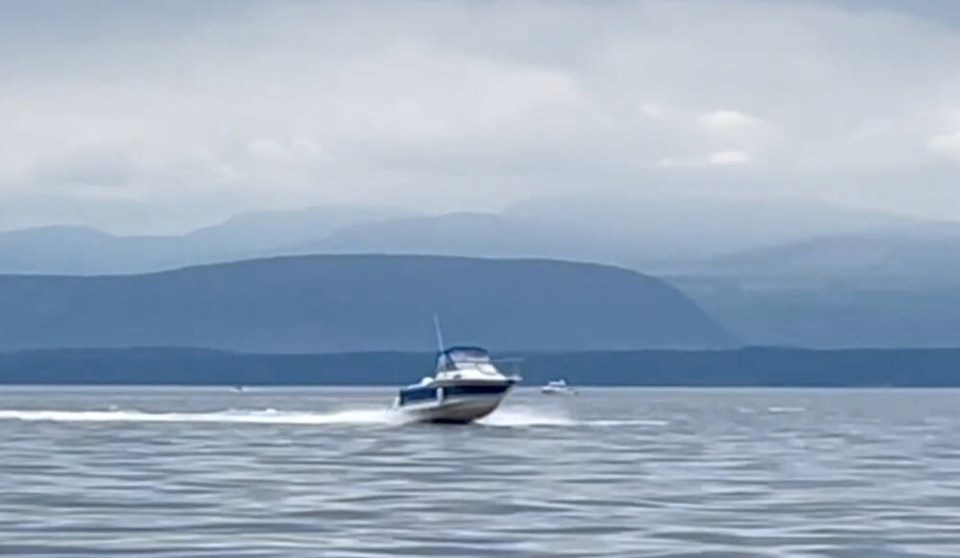Researchers are shocked and saddened that at least eight humpback whales have been hit by vessels off the B.C. coast in less than a month.
The whale strikes between July 20 and Aug. 11 have included humpbacks near Tofino and Campbell River. Three other hits were made by a B.C. Ferries vessel, a large catamaran ferry and a cruise ship, according to the Marine Education and Research Society.
The identities and extent of the injuries or condition of six of the whales struck by boats isn’t known, said Jackie Hildering, a researcher with the Canadian Humpback Whale Collaboration based in Port McNeill.
Only one of the hit whales, known as Harlequin, is being monitored byCampbell River whale-watching companies and Straitwatch. The humpback was struck by a fast-moving pleasure boat on Aug. 11 at Wilby Shoals near Campbell River. The impact was captured in a dramatic video shared by the marine education society on social media.
“We’re sharing it to increase the awareness of collisions and what can be done to reduce risk — from boater education, the use of whale-warning flags to slowing down and avoidance zones,” said the society.
The area where the collision happened — from Sutil Channel to Mittlenatch — is known to have several humpbacks that gorge on krill and small fish as they prepare to migrate back to Mexico, said Hildering.
Hildering said a whale-watching boat crew had raised its whale-warning flag and were frantically waving at the pleasure boat, but the driver didn’t seem to notice. The boat slowed to a stop after striking the whale and a huge spray of water appeared.
“This is not about blame and vilification,” said Hildering. “This is about learning.”
Harlequin showed no visible signs of traumatic injuries, but obviously suffered blunt force trauma from the impact.
The whale struck off Tofino was also a recent hit and had a massive gash on its back
Tofino ecotourism companies are attempting to monitor the whale. To date, there is not a fluke photo of the whale allowing for identification.
It is not known if the boat operator who hit the whale reported the collision.
Hildering said federal law requires all collisions and entanglements to be reported to the Department of Fisheries and Oceans as humpbacks are a species at risk and recovering from near extinction after hunting nearly wiped them out.
Injured whales often die and sink or wash up on remote beaches and the cause of death isn’t always apparent, she said.
“Knowing who the whale is may allow for a better understanding of when the hit happened,” said Hildering. “We share this to increase awareness of the law, the risk of collision to both boaters and whales and that there is so much that can be done to reduce the threat of collision.
“You can have an accident even when armed with much knowledge. But there is still such a lack of awareness among many boaters about the signs of whale presence, areas of abundance, humpback whale behaviour … often travelling in unpredictable patterns and not being aware of vessels, and how much it helps to be vigilant and reduce speed.”
Hildering said more education is needed for operators of vessels of all sizes, including watching for blows, birds on the water as a sign of a feeding area and known areas of humpback travel and feeding. There is also a need for slowdown zones in known humpback habitat at certain times of the year, she said.
DFO did not immediately respond to requests for information about the humpback strikes.
All of the cases over the past month were reported by whale-watching companies, recreational vessel operators or crew on ferries and cruise ships.
Seven of the collisions occurred from Campbell River and the North Island to the central and north coasts.
B.C. Ferries’ Northern Expedition struck a humpback on the central coast on July 20. It was a “devastating hit” according to a passenger on board, said Hildering. A cruise-ship passenger also reported that a humpback was struck in Hecate Strait on July 21 when the massive vessel tried to avoid one whale and hit another, she said.
Hildering said humpbacks can be feeding, socializing or resting and sleeping just below the surface.
Tips for avoiding collisions with whales
• Baleen whales like humpbacks can remain submerged for 15 to 20 minutes and often exhibit random travel patterns.
• Whales may surface without warning and can be difficult to avoid, especially if boaters are travelling at speed. They can also suddenly become acrobatic and breach without warning.
• To increase safety for both boaters and marine wildlife, always be on the lookout for blows and other indicators of whale presence such as aggregations of birds.
• Watch for vessels flying the whale-warning flag.
• Increase vigilance in areas of known whale density.
• Signal commercial vessels to the presence of whales through the use of the Whale Report Alert System app.




